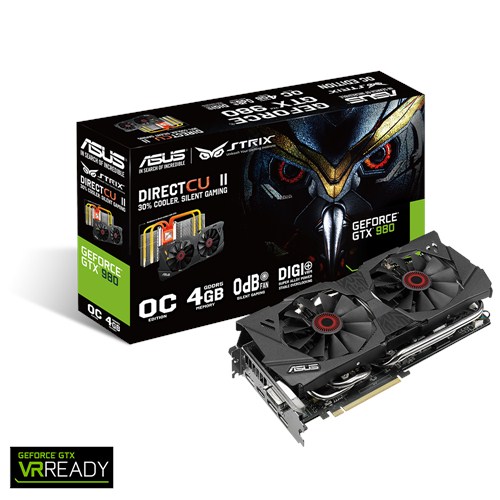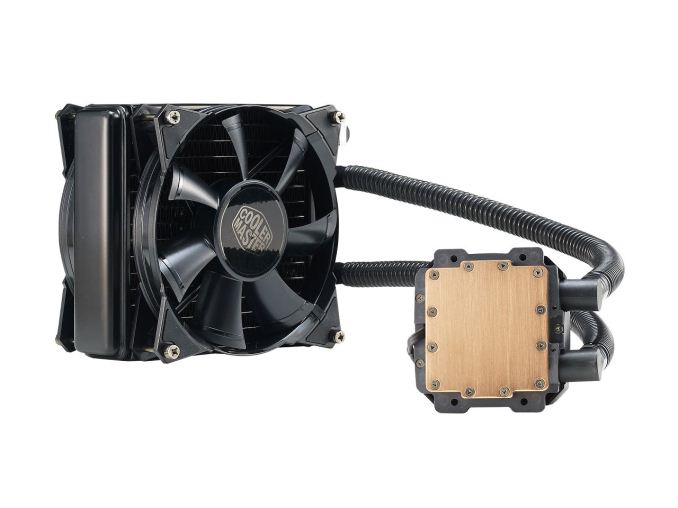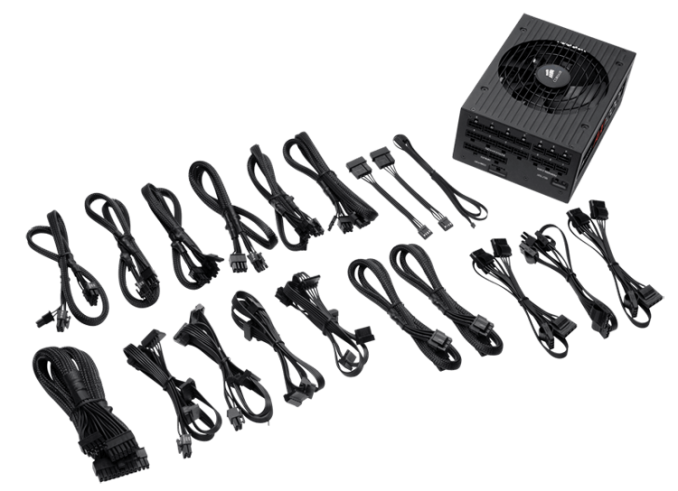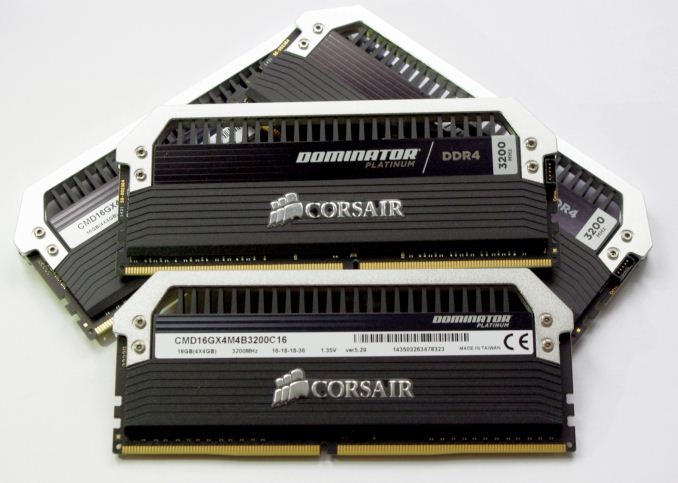The Intel Core i5-7600K (91W) Review: The More Amenable Mainstream Performer
by Ian Cutress on January 3, 2017 12:01 PM ESTTest Bed and Setup
As with every CPU launch, there are a number of different directions to take the review. We have dedicated articles comparing the IPC of the new Kaby Lake line of CPUs, as well as a look into overclocking performance as a whole. We have had almost every desktop-class CPU family since Sandy Bridge tested in our benchmark suite, although only the latest have been retested. Due to timing, we were able to test all three of the new Kaby Lake-K processors, and retest the several Skylake processors, however we do have some CPU data for comparison for Haswell, Ivy Bridge, and Sandy Bridge. It will interesting to see how the CPU performance out-of-the box has adjusted over the last five generations.
As per our testing policy, we take each CPU and place it in a suitable high-end motherboard and equip the system with a suitable amount of memory running at the processor maximum supported frequency. This is also typically run at JEDEC subtimings where possible. It is noted that some users are not keen on this policy, stating that sometimes the maximum supported frequency is quite low, or faster memory is available at a similar price, or that the JEDEC speeds can be prohibitive for performance. While these comments make sense, ultimately very few users apply memory profiles (either XMP or other) as they require interaction with the BIOS, and most users will fall back on JEDEC supported speeds - this includes home users as well as industry who might want to shave off a cent or two from the cost or stay within the margins set by the manufacturer. Where possible, we will extend out testing to include faster memory modules either at the same time as the review or a later date.
| Test Setup | |
| Processor | Intel Core i7-7600K (Retail Stepping), 91W, $303 4 Cores, 8 Threads, 3.8 GHz (4.2 GHz Turbo) |
| Motherboards | ASRock Z270 Extreme4 MSI Z270 Gaming M7 |
| Cooling | Cooler Master Nepton 140XL |
| Power Supply | OCZ 1250W Gold ZX Series Corsair AX1200i Platinum PSU |
| Memory | Corsair DDR4-2400 C15 2x8 GB 1.2V or G.Skill Ripjaws 4 DDR4-2400 C15 2x8 GB 1.2V |
| Memory Settings | JEDEC @ 2400 |
| Video Cards | ASUS GTX 980 Strix 4GB MSI GTX 770 Lightning 2GB (1150/1202 Boost) ASUS R7 240 2GB |
| Hard Drive | Crucial MX200 1TB |
| Optical Drive | LG GH22NS50 |
| Case | Open Test Bed |
| Operating System | Windows 7 64-bit SP1 |
Readers of our reviews will have noted the trend in modern motherboards to implement a form of MultiCore Enhancement / Acceleration / Turbo (read our report here) on their motherboards. This does several things, including better benchmark results at stock settings (not entirely needed if overclocking is an end-user goal) at the expense of heat and temperature. It also gives in essence an automatic overclock which may be against what the user wants. Our testing methodology is ‘out-of-the-box’, with the latest public BIOS installed and XMP enabled, and thus subject to the whims of this feature. It is ultimately up to the motherboard manufacturer to take this risk – and manufacturers taking risks in the setup is something they do on every product (think C-state settings, USB priority, DPC Latency / monitoring priority, overriding memory sub-timings at JEDEC). Processor speed change is part of that risk, and ultimately if no overclocking is planned, some motherboards will affect how fast that shiny new processor goes and can be an important factor in the system build.
Many thanks to...
We must thank the following companies for kindly providing hardware for our multiple test beds. Some of this hardware is not in this test bed specifically, but is used in other testing.
Thank you to AMD for providing us with the R9 290X 4GB GPUs. These are MSI branded 'Gaming' models, featuring MSI's Twin Frozr IV dual-fan cooler design and military class components. Bundled with the cards is MSI Afterburner for additional overclocking, as well as MSI's Gaming App for easy frequency tuning.
The R9 290X is a second generation GCN card from AMD, under the Hawaii XT codename, and uses their largest Sea Islands GPU die at 6.2 billion transistors at 438mm2 built at TSMC using a 28nm process. For the R9 290X, that means 2816 streaming processors with 64 ROPs using a 512-bit memory bus to GDDR5 (4GB in this case). The official power rating for the R9 290X is 250W.
The MSI R9 290X Gaming 4G runs the core at 1000 MHz to 1040 MHz depending on what mode it is in (Silent, Gaming or OC), and the memory at 5 GHz. Displays supported include one DisplayPort, one HDMI 1.4a, and two dual-link DVI-D connectors.
Further Reading: AnandTech's AMD R9 290X Review
Thank you to ASUS for providing us with GTX 980 Strix GPUs. At the time of release, the STRIX brand from ASUS was aimed at silent running, or to use the marketing term: '0dB Silent Gaming'. This enables the card to disable the fans when the GPU is dealing with low loads well within temperature specifications. These cards equip the GTX 980 silicon with ASUS' Direct CU II cooler and 10-phase digital VRMs, aimed at high-efficiency conversion. Along with the card, ASUS bundles GPU Tweak software for overclocking and streaming assistance.
The GTX 980 uses NVIDIA's GM204 silicon die, built upon their Maxwell architecture. This die is 5.2 billion transistors for a die size of 298 mm2, built on TMSC's 28nm process. A GTX 980 uses the full GM204 core, with 2048 CUDA Cores and 64 ROPs with a 256-bit memory bus to GDDR5. The official power rating for the GTX 980 is 165W.
The ASUS GTX 980 Strix 4GB (or the full name of STRIX-GTX980-DC2OC-4GD5) runs a reasonable overclock over a reference GTX 980 card, with frequencies in the range of 1178-1279 MHz. The memory runs at stock, in this case 7010 MHz. Video outputs include three DisplayPort connectors, one HDMI 2.0 connector and a DVI-I.
Further Reading: AnandTech's NVIDIA GTX 980 Review
Thank you to Cooler Master for providing us with Nepton 140XL CLCs. The Nepton 140XL is Cooler Master's largest 'single' space radiator liquid cooler, and combines with dual 140mm 'JetFlo' fans designed for high performance, from 0.7-3.5mm H2O static pressure. The pump is also designed to be faster, more efficient, and uses thicker pipes to assist cooling with a rated pump noise below 25 dBA. The Nepton 140XL comes with mounting support for all major sockets, as far back as FM1, AM2 and 775.
Further Reading: AnandTech's Cooler Master Nepton 140XL Review
Thank you to Corsair for providing us with an AX1200i PSU. The AX1200i was the first power supply to offer digital control and management via Corsair's Link system, but under the hood it commands a 1200W rating at 50C with 80 PLUS Platinum certification. This allows for a minimum 89-92% efficiency at 115V and 90-94% at 230V. The AX1200i is completely modular, running the larger 200mm design, with a dual ball bearing 140mm fan to assist high-performance use. The AX1200i is designed to be a workhorse, with up to 8 PCIe connectors for suitable four-way GPU setups. The AX1200i also comes with a Zero RPM mode for the fan, which due to the design allows the fan to be switched off when the power supply is under 30% load.
Further Reading: AnandTech's Corsair AX1500i Power Supply Review
Thank you to Crucial for providing us with MX200 SSDs. Crucial stepped up to the plate as our benchmark list grows larger with newer benchmarks and titles, and the 1TB MX200 units are strong performers. Based on Marvell's 88SS9189 controller and using Micron's 16nm 128Gbit MLC flash, these are 7mm high, 2.5-inch drives rated for 100K random read IOPs and 555/500 MB/s sequential read and write speeds. The 1TB models we are using here support TCG Opal 2.0 and IEEE-1667 (eDrive) encryption and have a 320TB rated endurance with a three-year warranty.
Further Reading: AnandTech's Crucial MX200 (250 GB, 500 GB & 1TB) Review
Thank you to G.Skill for providing us with memory. G.Skill has been a long-time supporter of AnandTech over the years, for testing beyond our CPU and motherboard memory reviews. We've reported on their high capacity and high-frequency kits, and every year at Computex G.Skill holds a world overclocking tournament with liquid nitrogen right on the show floor. One of the most recent deliveries from G.Skill was their 4x16 GB DDR4-3200 C14 Kit, which we are planning for an upcoming review.
Further Reading: AnandTech's Memory Scaling on Haswell Review, with G.Skill DDR3-3000
Thank you to Corsair for providing us with memory. Similarly, Corsair (along with PSUs) is also a long-time supporter of AnandTech. Being one of the first vendors with 16GB modules for DDR4 was a big deal, and now Corsair is re-implementing LEDs back on its memory after a long hiatus along with supporting specific projects such as ASUS ROG versions of the Dominator Platinum range. We're currently looking at our review pipeline to see when our next DRAM round-up will be, and Corsair is poised to participate.
Further Reading: AnandTech's Memory Scaling on Haswell-E Review

















70 Comments
View All Comments
Magichands8 - Tuesday, January 3, 2017 - link
This Optane looks completely useless. But Optane DRAM sounds like it could be interesting. Depending upon how much slower it is.lopri - Wednesday, January 4, 2017 - link
I immediately thought of "AMD Memory" which AMD launched after the Bulldozer flop. But then again Intel have been going after this storage caching scheme for years now and I do not think it has taken them anywhere.smilingcrow - Tuesday, January 3, 2017 - link
Games frame rates to 2 decimal points adds nothing but making it harder to scan the numbers quickly. Enough already.1_rick - Tuesday, January 3, 2017 - link
One place where the extra threads of an i7 are useful is if you're using VMs (maybe to run a database server or something.) I've found that an i5 with 8GB can get bogged down pretty drastically just from running a VM.Meteor2 - Tuesday, January 3, 2017 - link
I kinda think that if you're running db VMs on an i7, you're doing it wrong.t.s - Wednesday, January 4, 2017 - link
or if you're Android developer using Android Studio.lopri - Wednesday, January 4, 2017 - link
That is true but as others have implied you can get 6 or 8 real core Xeons for cheaper than these new Kaby Lake chips if VM is what you need the performance of a CPU is for.ddhelmet - Tuesday, January 3, 2017 - link
Well I am more glad now that I got a Skylake. Even if I waited for this the performance increase is not worth it.Kaihekoa - Tuesday, January 3, 2017 - link
Y'all need to revise your game benchmarking analysis. At least use some current generation GPUs, post the minimum framerates, and test at 1440p. The rest of your review is exceptional, but the gaming part needs some modernization, please.lopri - Wednesday, January 4, 2017 - link
I thank the author for a clear yet thorough review. A lot of grounds are covered and the big picture of the chip's performance and features is well communicated. I agree with the author's recommendation at the end as well. I have not felt that I am missing out anything compared to i7's while running a 2500K for my gaming system, and unless you know for certain that you can take advantage of HyperThreading, spending the difference in dollars toward an SSD or a graphics card is a wiser expenditure that will provide you with better computing experience.Having said that, I am wtill not compelled to upgrade my 2500K which has been running at 4.8 GHz for years. (It does 5.0 GHz no problem but I run it at 4.8 to leave some "headroom") While I think the 7600K is barely a worthy upgrade (finally!) on its own light, but the added cost cannot be overlooked. A new motherboard, new memory, and potentially a new heat sink will quickly add to the budget, and I am not sure if it is going to be worth all the expenses that will follow.
Of course all that could be worthwhile if overclocking was fun, but Intel pretty much have killed overclocking and the overclocking community. Intentionally if I might add. Today overclocking does not give one a sense of discovery or accomplishment. Competition between friendly enthusiasts or hostile motherboard/memory vendors has disappeared. Naturally there is no accumulation or exchange of knowledge in the community, and conversations have become frustrating and vain due to lack of overclocking expertise. Only some brute force overclocking with dedicated cooling has some following, and the occasional "overclocking" topics in the forums are really a braggadocio in disguise, of which the competition underneath is really about who spent the most on their rigs with the latest blingy stuff. Needless to say those are not as exciting or illuminating as the real overclocking of the yore, and in my opinion there are better ways to spend money for such a self-gratification without the complication that often accompanies overclocking which in the end fails to impress.
Intel might have a second thought about its overclocking policies now, but just as many things Intel have done in recent years, it is too little too late. And their chips have no headroom anyway. My work system is due for an upgrade and I am probably going to pick up a couple of E2670s which will give me 16 real cores for less than $200. Why bother with the new stuff when the IPC gain is meager and there is no fun in overclocking? And contribute to Intel's revenue? Thank you but no thank you.
P.S. Sorry I meant to commend the author for the excellent (albeit redundant) review but ended up ranting about something else. Oh well, carry on..